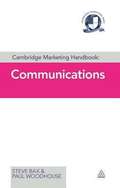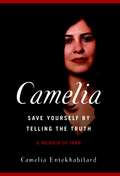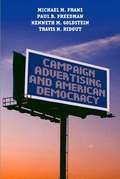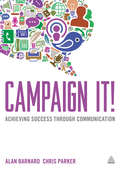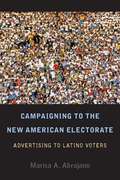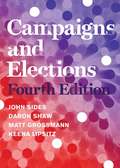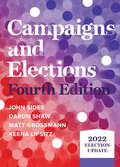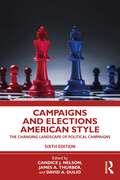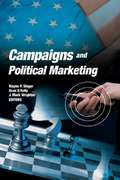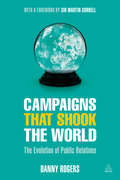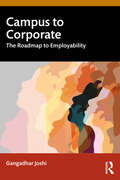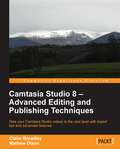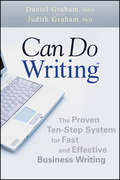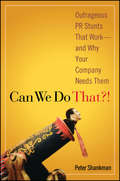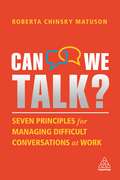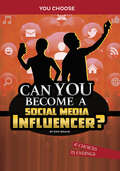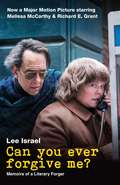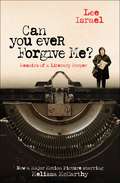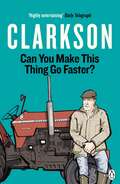- Table View
- List View
Cambridge Marketing Handbook: Communications
by Paul Woodhouse Steve BaxCambridge Marketing Handbook: Marketing Communications looks at the contemporary integrated communications mix, in the light of the changes in digital marketing and aims to give an overview of the current tools that marketers need to have under their belts. Coverage includes: the purpose and uses of communications; the promotional mix; advertising tools; public relations and media tools; the meaning of consumer behaviour; communications plans and evaluation methods. The Handbook also examines the buyer behaviour theories for B2C and B2C, looking at the elements that make up the process of purchase.
Cambridge Studies in Nineteenth-Century Literature and Culture: Dickens and The Business of Death
by Claire WoodCharles Dickens is famous for his deathbed scenes, but these have rarely been examined within the context of his ambivalence towards the Victorian commodification of death. Dickens repeatedly criticised ostentatious funeral and mourning customs, and asserted the harmful consequences of treating the corpse as an object of speculation rather than sympathy. At the same time, he was fascinated by those who made a living from death and recognised that his authorial profits implicated him in the same trade. This book explores how Dickens turned mortality into the stuff of life and art as he navigated a thriving culture of death-based consumption. It surveys the diverse ways in which death became a business, from body-snatching, undertaking, and joint-stock cemetery companies, to the telling and selling of stories. This broad study offers fresh perspectives on death in The Old Curiosity Shop and Our Mutual Friend, and discusses lesser-known works and textual illustrations.
Cambridge Studies in Nineteenth-Century Literature and Culture: Translation as Transformation in Victorian Poetry
by Annmarie DruryTranslation as Transformation in Victorian Poetry illuminates the dynamic mutual influences of poetic and translation cultures in Victorian Britain, drawing on new materials, archival and periodical, to reveal the range of thinking about translation in the era. The results are a new account of Victorian translation and fresh readings both of canonical poems (including those by Browning and Tennyson) and of non-canonical poems (including those by Michael Field). Revealing Victorian poets to be crucial agents of intercultural negotiation in an era of empire, Annmarie Drury shows why and how meter matters so much to them, and locates the origins of translation studies within Victorian conundrums. She explores what it means to 'sound Victorian' in twentieth-century poetic translation, using Swahili as a case study, and demonstrates how and why it makes sense to consider Victorian translation as world literature in action.
Cambridge Textbooks in Linguistics: Conversation Analysis
by Rebecca CliftWe live our lives in conversation, building families, societies and civilisations. In over seven thousand languages across the world, the basic infrastructure by which we communicate remains the same. This is the first ever book-length linguistic introduction to conversation analysis (CA), the field that has done more than any other to illuminate the mechanics of interaction. Starting by locating CA by reference to a number of cognate disciplines investigating language in use, it provides an overview of the origins and methodology of CA. By using conversational data from a range of languages, it examines the basic apparatus of sequence organisation: turn-taking, preference, identity construction and repair. As the basis for these investigations, the book uses the twin analytic resources of action and sequence to throw new light on the origins and nature of language use.
Camelia: Save Yourself by Telling the Truth-A Memoir of Iran
by Camelia Entekhabifard George MurerCamelia Entekhabifard was six years old in 1979 when the shah of Iran was overthrown by revolutionary supporters of the Ayatollah Khomeini. By the age of sixteen, Camelia was a nationally celebrated poet, and at eighteen she was one of the youngest reformist journalists in Tehran. Just eight years later she was imprisoned, held in solitary confinement, and charged with breaching national security and challenging the authority of the Islamic regime. Camelia is both a story of growing up in post-revolutionary Tehran and a haunting reminder of the consequences of speaking the truth in a repressive society.
Campaign Advertising and American Democracy
by Franz Freedman Michael M. Paul B. Goldstein Kenneth M. Ridout Travis N.Campaign Advertising and American Democracyexplores the relationship between exposure to political advertisements and voter behavior. Contrary to widely held beliefs, political ads do not turn people off to politics.
Campaign Communication and Political Marketing
by Philippe J. MaarekCampaign Communication and Political Marketing is a comprehensive, internationalist study of the modern political campaign. It indexes and explains their integral components, strategies, and tactics. Offers comparative analyses of campaigns from country to country Covers topics such as advertising strategy, demography, the effect of campaign finance regulation on funding, and more Draws on a variety of international case studies including the campaigns of Barack Obama and Nicolas Sarkozy Analyses the impact of digital media and 24/7 news cycle on campaign conduct
Campaign It!
by Alan Barnard Chris ParkerCampaign It! provides a new definition and understanding of what makes a cause. It explains why, in our modern society, a communications campaign is the most powerful way to achieve success. And it demonstrates how it is possible to create and apply an irresistible communications campaign to any aspect of our professional and personal lives. Whatever the situation, we always need to influence others if we are to achieve our goals. Campaign It! can help you do that. It's written by leading professionals who demonstrate that communications can be created in such a way that the message becomes powerful and compelling. At the heart of every successful campaign is a cause that motivates and drives a desire to succeed. With such a cause anyone can apply the Campaign It! model to devise a communications campaign to create success.
Campaign It!: Achieving Success Through Communication
by Alan Barnard Chris ParkerThis ground-breaking book redefines campaigning and explains how to create and deliver a compelling campaign that can be applied in any aspect of your professional and personal life.Based on a claim that is both bold and true, this book introduces and demonstrates a new, unique and complete approach to communication for change - the Campaign It! model. It is a model developed and used by leading professionals in communications and campaigning to create influence and change at the highest levels business, politics and society. It is transferable to any sphere of life. It is tried and tested. And it works.Simply put: to achieve change and be successful you always have to inform, persuade and gain agreement from significant people and organizations. The Campaign It! model enables you to do this powerfully and positively.
Campaigning to the New American Electorate
by Marisa AbrajanoAbrajano (political science, U. of California-San Diego) investigates whether ethnic political campaigns are successful at winning ethnic minority votes, and examines the consequences, if any, that ethnic political campaigns have on the political health and well being of that segment of the ethnic group being targeted. To these ends, she looks at the Spanish-language and English-language televised political advertisements created for the 2000 and 2004 election cycles, and examines their effect on Latino political behavior. Her topics include a theory of information-based advertising, candidates' advertising strategies, advertising effects on the Latino vote, and the future of ethnically targeted campaigns. An epilogue considers the 2008. Annotation ©2010 Book News, Inc. , Portland, OR (booknews. com)
Campaigns and Elections (Fourth Edition)
by Matt Grossmann John Sides Keena Lipsitz Daron ShawThe #1 book examines contemporary campaigns and elections—now updated through 2020 Thoroughly revised and updated through the 2020 elections, the Fourth Edition of Campaigns & Elections uses a consistent framework to reveal the strategies and choices that face candidates and other practitioners in the American political system. The authors have set out to help students answer the many questions they have about campaigns while spotlighting contemporary political science research to help them do so. This purchase offers access to the digital ebook only.
Campaigns and Elections (Fourth Election Update Edition): 2022 Election Update
by Matt Grossmann John Sides Keena Lipsitz Daron ShawThe #1 book examines contemporary campaigns and elections—now updated through 2022. Thoroughly revised and updated through the 2022 elections, the Fourth Edition of Campaigns and Elections uses a consistent framework to reveal the strategies and choices that face candidates and other practitioners in the American political system. The authors help students answer the many questions they have about campaigns while spotlighting contemporary political science research in the process. This purchase offers access to the digital ebook only.
Campaigns and Elections American Style: The Changing Landscape of Political Campaigns
by James A. Thurber Candice J. Nelson David A. DulioWith new and revised chapters throughout, the sixth edition of Campaigns and Elections American Style allows academics and campaign professionals the chance to explain how the COVID-19 pandemic, 2020 general election, and 2022 midterm election upended the campaign process and changed the landscape of political campaigns forever. Offering a unique and careful mix of Democrat and Republican, academic and practitioner, and male and female campaign perspectives, this volume scrutinizes national and local-level campaigns. Students, citizens, candidates, and campaign managers learn not only how to win elections but also why it is imperative to do so in a safe and ethical way. Perfect for a variety of courses in American government, this book is especially valuable to schools of campaign management and campaign professionals working at every level from the local to the global. Highlights of the Sixth Edition Covers the 2020 and 2022 elections with an eye to 2024. Examines changes to the campaign process as a result of COVID-19 and puts them in context with campaign traditions over time. Includes a new organization that moves campaign finance up front to emphasize the centrality of fundraising to successful campaigns. Offers more data to inform campaign planning and management, especially related to key topics such as the change in news media coverage, the growth and use of social media, the use of "big data" in campaigns, and changes in field and voting rules and policies.
Campaigns and Political Marketing
by Sean Kelly Wayne Steger Mark WrightonUnderstand the theoretical-and practical-aspects of political marketing!Over the past few years political marketing strategies have been refined with the help of new findings in political science research. Campaigns and Political Marketing clearly discusses the most recent political science research studies and theories that political activists and professionals can apply to effectively campaign for an issue or candidate. This text is an invaluable compilation of research, theory, and practical application from political science experts across the country that guides readers through the complexities of everyday political marketing and campaigning. Readers get the critical knowledge needed on how to best affect public viewpoints and gain the strongest advantage over the opposition.Campaigns and Political Marketing is packed with information and insights every political activist will find useful. It coherently explains the real world of campaign politics and elections, presenting the everyday issues that political consultants face in the field, all made easily understandable even to the novice. This scholarly examination provides lessons that can be effectively applied to just about any situation. Political crises and scandals are discussed in detail, with research and historical studies that illuminate practical ways to deal with any problem. The book is extensively referenced and uses graphs and charts to clearly explain research findings.Campaigns and Political Marketing answers these tough questions: What is the role of professional campaign consultants-and their value? How have the past four presidential elections revised the state presidential vote forecasting equation? How does interest groups&’ resource distribution differ from resource allocation decisions made by candidates&’ organizations and the national political parties? How does congressional campaign candidate scheduling differ from legislative candidate scheduling? How effective are attack messages in generating media coverage early in a campaign? How do political professionals define campaign crises? What are the differences in public reaction when a candidate from one or the other of the two major parties is in a scandal? How is public opinion affected when tragedy strikes a political candidate?Campaigns and Political Marketing is stimulating, idea-generating reading that is perfect for educators and students in marketing, communications, and political science; practitioners in campaigns and marketing; and political activists of all types.
Campaigns that Shook the World
by Danny RogersOver the past four decades, a series of PR campaigns have helped to shape popular culture and influence public opinion. Campaigns that Shook the World provides the inside story on the pivotal PR campaigns of the past four decades, following and celebrating the maturation and expansion of the PR industry towards today's practice. It examines ten of these campaigns in detail from the 1970s to the present day, explaining their strategy and tactics, looking at the imagery and icons they created and interviewing the powerful, flamboyant personalities who crafted and executed these seminal projects. Each chapter is built around extended case studies including Thatcherism (1979), New Labour, The Royal Family, The Rolling Stones (1981), David Beckham, London 2012, Product [RED], The Obama Campaign (2008) and Dove Real Beauty. Featuring campaigns by Saatchi & Saatchi, Bell Pottinger, Ogilvy, Freuds, Pitch and other well-known agencies, Campaigns that Shook the World grapples with PR's uneasy place at the nexus of politics and celebrity, holding the best campaigns up to scrutiny and showcasing just how powerful PR can be as an instrument of change, for the good, and at times for the less than good. It contains insights from Alastair Campbell, Lord Tim Bell, Alan Edwards, Paddy Harverson, Matthew Freud and many others.
Campus to Corporate: The Roadmap to Employability
by Gangadhar JoshiThis book offers a fresh perspective on the techniques of coping with the challenges of transitioning from student life to a professional corporate environment. It presents an integrated approach and a workable plan for students to pursue and add value to their careers by developing life and business skills that could be seamlessly woven into a well-rounded personality.This book has been designed to help students stand out in terms of knowledge, skills and attitude. It delineates the transition needs (from classrooms to workplace) with clearly defined end results, imparting skills required to excel individually and as part of a team, as a matter of regular practise while working in the corporate world.The primary aim of this book is not just to place graduates in the corporate world but also to enhance their employability skills to make them globally employable in diverse disciplines. Replete with easy-to-use tips and tools with real-world applications, this book will be of immense value to final year graduates and post-graduate students, as well as placement officers of higher education institutions looking to achieve a good placement record.
Camtasia Studio 8: Advanced Editing and Publishing Techniques
by Mathew Dixon Claire BroadleyA practical guide packed with examples that will show you how to implement the different features of Camtasia Studio 8 and create professional looking projects.If you are familiar with Camtasia Studio and you want to experiment with more advanced techniques, then this is the guide you have been looking for!
Can Do Writing: The Proven Ten-Step System for Fast and Effective Business Writing
by Daniel Graham Judith GrahamA simple, ten-step system for mastering the art of effective, persuasive business or technical writing "The Grahams' system is the best way to transform data and ideas into meaningful information necessary to make profitable decisions. Their system works every time." —Steven Laposa, PhD, MBA, Loveland Commercial Endowed Chair in Real Estate, Colorado State University "The Grahams' straightforward program helps my teams create clear and concise reports, letters, and other documents with minimal effort. I want this program to become the standard for my teams." —Bill Walter, Senior Vice President, Government and Infrastructure Division, KBR "The Can Do Writing system made my career! I used it to write a winning business plan and proposal, and now I use it every day for all communications. Can Do Writing provides valuable insights into business and management as well as writing techniques." —Christian Robey, President, DC Progress You may be an expert at what you do, but if you can't communicate effectively in writing it may not matter. For scientists, businesspeople, and professionals in fields from engineering to public relations, the art of writing well can be a vital key to professional success. Luckily, you don't need an English degree to produce top-class writing. If you're one of the millions of people who have to write clear, persuasive, understandable documents for your job, Can Do Writing is for you. Whether you're writing a business plan, a scientific paper, a press release, or anything else, this simple, straightforward guide will show you how to do it quickly, with style and confidence. You'll learn how to: Understand your audience and subject matter Develop a simple, five-part purpose statement to keep you on track Organize your main points into a coherent, sensible order Edit your work for clarity, coherence, organization, and logic Economize your words to craft a concise, powerful document Make your documents easily readable for any audience
Can Science Be Witty?: Science Communication Between Critique and Cabaret
by Marc-Denis Weitze Wolfgang M. Heckl Wolfgang Chr. Goede"Can science be funny?" takes a close look at an element of modern science communication that is as innovative as it is promising for the future: comedy!Readers are guided through vividly presented academic theory as well as exciting hands-on and best practice examples from renowned practitioners and cabaret artists:- What do sheep's cheese and car tires have in common?- Can laughter break down walls?- How does "Die Anstalt" work?- How does magic create knowledge?- Is there humor in museums?- When a Dalmatian comes to the cash register- Three steps to humor- Serving suggestion for the Holy Spirit- dictatorship of stupidity- And much more!But it's not all just funny. Comedy can also take away some of the biting sharpness of criticism, making it digestible, even palatable, for the addressees."Can Science Be Funny?" navigates between criticism and cabaret, tackling comedy in various guises from different perspectives.22 contributions show how the results of science, research and technology can be brought to the general public in new ways. In particular, they also demonstrate how humour can be used as a critical and questioning force - valuable for all types of communication and helpful so that they come across more shrewdly in the future.
Can We Do That!
by Peter ShankmanThis fun and friendly book looks at real-life PR stunts that will blow your mind and inspire you to develop innovative and creative ways to get your company noticed. PR guru Peter Shankman chronicles the most ridiculous, outrageous, and possibly crazy PR stunts of all time-explaining why some work and others don't. This is a funny, insightful guide to winning the PR game.
Can We Talk?: Seven Principles for Managing Difficult Conversations at Work
by Roberta Chinsky MatusonAre you avoiding an uncomfortable conversation at work? If you're an executive or a team leader, strengthening your organization's ability to have difficult conversations is necessary and worth the discomfort.The key to successful dialogue starts and ends with changing the conversation. Recognizing that it takes two people to engage in meaningful outcomes, Can We Talk? outlines what each contributor needs to do to achieve the best possible result. Using examples from everyday work situations, this book offers guidance on how to create the right conditions for a meaningful discussion. The author identifies the seven key principles that enable both parties to gain a deeper understanding of what the other person may be thinking and will help establish their point of view more clearly: confidence, clarity, compassion, curiosity, compromise, credibility, courage.Can We Talk? includes examples and advice from those who have been there and thrived, as well as lessons learned from conversation failures and example scripts of productive conversations. Readers will learn how to prepare, start and manage the potentially challenging exchange of words that typically occur at work, and come away with an understanding that for any conversation to take place, both parties must be engaged.
Can You Become a Social Media Influencer?: An Interactive Adventure (You Choose: Chasing Fame and Fortune)
by Eric BraunDo you want to make social media your microphone to the world? Maybe you're a trend-setter or a social justice leader. Now is your chance to set out a path to social media domination. Face real-life choices that will help you learn about marketing, messaging, and what it takes to make it as a social media star.
Can You Ever Forgive Me?: Memoirs of a Literary Forger
by Lee IsraelNow a major motion picture starring Melissa McCarthy—Lee Israel’s hilarious and shocking memoir of the astonishing caper she carried on for almost two years when she forged and sold more than three hundred letters by such literary notables as Dorothy Parker, Edna Ferber, Noel Coward, and many others.Before turning to her life of crime—running a one-woman forgery business out of a phone booth in a Greenwich Village bar and even dodging the FBI—Lee Israel had a legitimate career as an author of biographies. Her first book on Tallulah Bankhead was a New York Times bestseller, and her second, on the late journalist and reporter Dorothy Kilgallen, made a splash in the headlines. But by 1990, almost broke and desperate to hang onto her Upper West Side studio, Lee made a bold and irreversible career change: inspired by a letter she’d received once from Katharine Hepburn, and armed with her considerable skills as a researcher and celebrity biographer, she began to forge letters in the voices of literary greats. Between 1990 and 1991, she wrote more than three hundred letters in the voices of, among others, Dorothy Parker, Louise Brooks, Edna Ferber, Lillian Hellman, and Noel Coward—and sold the forgeries to memorabilia and autograph dealers. “Lee Israel is deft, funny, and eminently entertaining…[in her] gentle parable about the modern culture of fame, about those who worship it, those who strive for it, and those who trade in its relics” (The Associated Press). Exquisitely written, with reproductions of her marvelous forgeries, Can You Ever Forgive Me? is “a slender, sordid, and pretty damned fabulous book about her misadventures” (The New York Times Book Review).
Can You Ever Forgive Me?: Memoirs of a Literary Forger
by Lee IsraelBefore turning to the criminal life, running a onewoman forgery scam out of an Upper West Side studio shared with her tortoiseshell cat, and dodging the FBI, Lee Israel enjoyed a celebrated reputation as an author. When her writing career suddenly took a turn for the worse, she conceived of the astonishing literary scheme that fooled even many of the experts. Forging hundreds of letters from such collectible luminaries as Dorothy Parker, Noël Coward, and Lillian Hellman -- and recreating their autographs with a flourish -- Israel sold her "memorabilia" to dealers across the country, producing a collection of pitch-perfect imitations virtually indistinguishable from the voices of their real-life counterparts. Exquisitely written, with reproductions of her marvelous forgeries, Can You Ever Forgive Me? is Israel's delightful, hilarious memoir of a brilliant and audacious literary crime caper.
Can You Make This Thing Go Faster?
by Jeremy ClarksonThe hilarious new collection of stories and observations from Jeremy Clarkson - setting our off-kilter world to rights with thigh-slapping wit once again.Who is that tractor-driving Gentleman Farmer?Has Jeremy turned into a horny-handed son of the soil?These and other perplexing questions may or may not be answered in the latest volume of Clarkson's utterly unbiased musings on life, the universe and everything in between (except cars - this isn't one of his four-wheel drive books).Inside you'll also discover why:· Bathing in crude oil isn't for everyone· People who go fishing hate their kids· Noise-cancelling headphones will never silence James May· The rambler who stole his marrow is in for itFull of fact-checked opinions and ideas so good they're no longer following the science but chasing it up a tree, Can You Make This Thing Go Faster? is one hundred per cent guaranteed Clarkson . . .Praise for Clarkson:'Brilliant . . . laugh-out-loud' Daily Telegraph'Outrageously funny . . . will have you in stitches' Time Out'Very funny . . . I cracked up laughing on the tube' Evening Standard
